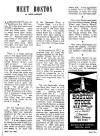
Home Page Meet Boston Menu Index
|
MEET BOSTON Friday, May 16, 1941 in What's New In Town W. J. Sidis |
Massachusetts has, according to the 1940 census, 30 cities and towns over 25,000 in population . . . more than any other state. Next in order come New Jersey, with 28, and Pennsylvania with 27. Massachusetts has nine cities of more than 90,000 people . . . again more than any other state. Ohio has eight, and New York and New Jersey seven each.
*
There is a large parking area in the region behind the Chamber of Commerce Building, and a short street, labeled Perkins Street, runs right across it . . . not more than a passageway across a parking space. Over a century ago, a man named Perkins, for whom the street was named, lived where this little passageway hits Pearl Street. He undertook tutoring about half a dozen blind children at his home, and it grew into America’s first school for the blind. The school was in South Boston for a while . . . at East Broadway and H Sts.; now it occupies a large building in Watertown. It was this school that first undertook printing books for the blind in America.
*
On the Squantum Peninsula, in Quincy, was the first landing field ever specially prepared for the use of airplanes. It is now a naval airport, and has been so since 1917. It is only about a mile by direct line from Fields Corner in Dorchester, but nearly four miles by present roads; but there is, on each side of the Neponset River, a “Victory Road,” and this would supply a good short-cut across if the river were not in the way. This marks where there was a bridge in World War days leading to the airport at Squantum. The bridge is now gone, but the name of Victory Road is left as a reminder of those other days.
*
In the summer of 1912, an airplane took off from the Saugus marshes for the Rockingham County Fair at Salem, N. H., carrying a bunch of letters from Boston for the county fair over the state line. That was the first time an airplane ever carried mail; and in these days when air mail is taken for granted, it might be interesting to remember that the very first air mail load originated here in Boston.
*
The old Esplanade, along the Back Bay front of the Charles River, was a unique sight . . . nothing else on earth quite like it . . . and one the like of which may not be seen again for a long time. For nearly two miles along the riverfront, from Charlesgate to near North Station, a paved walk led along the very edge of the water . . . one could have a pleasant walk on a summer day, separated from the water by only a small iron fence, and with a wide park stretching along on the other side. This was part of an improvement of the river front planned in 1907 and gave Boston, for over 20 years, a feature not to be seen anywhere else. It was spoiled by a further fill-in in 1931; but old-timers in town will long remember the old Esplanade.
*
How many Bostonians know the distinction between Rowes Wharf and Rowe’s Wharf? The first of these refers to the old ferry landing (now closed) of the former Narrow Gauge railway line. The other, Rowe’s Wharf, is the next pier, the landing of the Nantasket boats.
*
How many Bostonians can locate the address 105 Dartmouth? It is the official address of Back Bay Station.
*
The name Mystic, as applied to one of Boston’s rivers, contains no allusion to anything of a mysterious nature. It is an Indian name, and can fairly well be translated as Broad River.